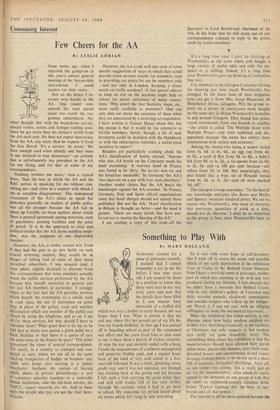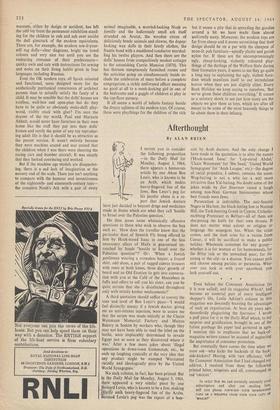Something to Play With
By MARY HOLLAND
SEARCHING around for a sense of grievance recently, I realised that I cannot remember a toy, in my life before I was nine years old. I am assured by those in a position to know that there were toys in my very' early years and now that the details have been filled in 1 can muster hazy memories of a stuffed doll which was was a bother to carry because she was larger than I was. What is certain is that she and any others like her passed out of my life be- fore my fourth birthday. At that age I was packed off to boarding school as part of the communal war effort and the years from four to nine seem to me to have been a period of toyless austerity. At nine the war and austerity ended with a bang. I made the acquaintance of a hitherto unsuspected and generous Dublin aunt, and a regular bean- feast of the kind of toys well suited to a five- year-old followed. It was a brief, glittering, retro- grade orgy and.it was not repeated, not through any drawing back at the giving end but because I felt such a fool carrying the giant teddy bear and doll with trunks full of her own clothes through the customs when I had to go back to school. My conscious toy period lasted about six -weeks which isn't long by any reckoning. So it was with some hope of self-discovery that I went off to assess the scope and possible effects of my early deprivation at the exhibition Toys of Today at the Bethnal Green Museum. Now I have a two-fold sense of grievance, neither part of which has anything to do with any toys produced during my lifetime. I feel cheated that we didn't have a museum like Bethnal Green, with its airy children's gallery of Victorian wax dolls, wooden animals, clockwork roundabouts and amiable keepers who follow up the belliger- ent 'Watch it, I can see you' with an obliging willingness to make the mechanical toys work.
What the exhibition has killed entirely is any illusions about how lucky modern children are in their toys. Searching frantically in the toyshops at Christmas one only suspects it, but modern toys really are quite dreadfully nasty. The astonishing thing about this exhibition is that the manufacturers should have allowed their garish nylon bears, plastic telly bunnies, jerry built semi- detached houses and unconvincing model cranes in soapy-looking plastic to be shown up in a place full of exquisite, fantastical playthings. After all, as one keeper was saying, 'this is really just an ad. for the manufacturers,' after which he sagely agreed to the demands of one group of kids that he open an eighteenth-century German dolls' house. 'Typical German this, the beds in cup- boards and all that pewter.'
The contrast is all the more pointed because the
museum, either by design or accident, has left the odd toy from the permanent exhibition stand- ing for the children to ooh and aah over amidst the dull gimcrack of the modern equivalents. There are, for example, the modern sew-it-your- self rag dolls—clear diagrams, bright tea towel colours and very nice too until you see the endearing romance of their predecessors— quirky owls and cats with instructions for sewing and notes on their living habits given in four languages including Russian.
Even the OK modern toys, all Spock oriented and functional, seem designed more for the aesthetically puritanical consciences of architect parents than to actually satisfy the fancy of a child. It may be sensible that the dolls' houses are roofless, wall-less and open-plan but do they have to be quite so obviously make-shift play- wood, visibly stuck with glue? I'm sure the doyens of the toy world, Paul and Marjorie Abbatt, would never have furniture in their own home like the stuff they put into their dolls' houses and surely the point of any toy reproduc- ing adult life is that it should be as attractive as the parent version. It wasn't entirely because they were machine crazed and war crazed that the children when I was there were cheering the racing cars and bomber aircraft. It was simply that they looked convincing and worked.
But if the machine age models are disappoint- ing, there is a sad lack of imagination at the nursery end of the scale. There just isn't anything to compare with the humour and inventiveness of the eighteenth- and nineteenth-century toys— the complete Noah's Ark with a pair of every animal imaginable, a worried-looking Noah en famille and the ludicrously small ark itself stranded on Ararat, the wooden circus of deliciously bendy animals and clowns, the dopey.: looking wax dolls in their lovely clothes, the frantic band with a maddened conductor marshal- ling his twelve players. And then there are the dolls' houses from comparitively modest cottages to the astonishing Currie Mansion (1874). This has thirteen sumptuously furnished rooms and the activities going on simultaneously inside in- clude the celebration of mass before a complete congregation, a richly uniformed officer meaning no good at all to a meek-looking girl in one of the bedrooms and a gaggle of children at play in the top-floor nursery.
It all seems a world of infinite fantasy beside the dreary ugliness of the modern toys. Of course, these were playthings for the children of the rich but it seems a pity that in spreading the goodies around a bit we have made them almost uniformly nasty. Moreover, the modern toys are far from cheap and it seems astonishing that their design should be on a par with the cheapest of neon-lit pub furniture—spindly plastic and garish nylon fur. If these are the uncompromisingly ugly, cheap-looking, violently coloured play- things of the darlings of the Welfare State during their formative years, it seems to me they go quite a long way to explaining the ugly, violent bore- dom which manifests itself to our incredulous horror when they are just slightly older. Every Bank Holiday we keep saying to ourselves, 'But we've given these children everything.' It comes as a salutary shock to see just how nasty are the objects we give them as toys, which are after all meant to be some of the most heavenly things to lie about them in their infancy.





























 Previous page
Previous page